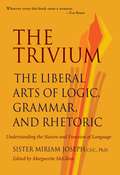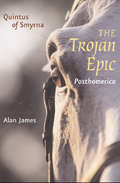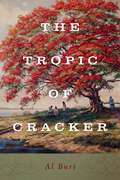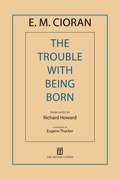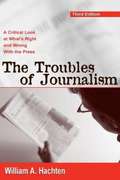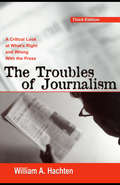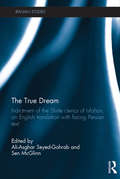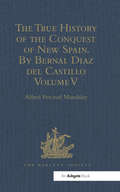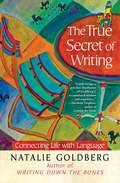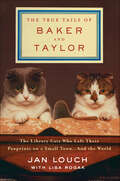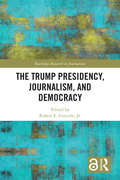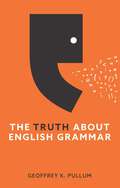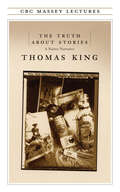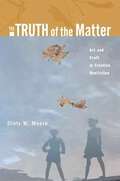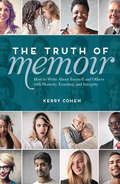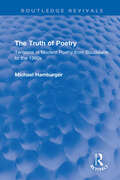- Table View
- List View
The Trivium: The Liberal Arts of Logic, Grammar, and Rhetoric
by Sister Miriam Joseph Marguerite McGlinnWho sets language policy today? Who made whom the grammar doctor? Lacking the equivalent of l'Académie française, we English speakers must find our own way looking for guidance or vindication in source after source. McGuffey's Readers introduced nineteenth-century students to "correct" English. Strunk and White's Elements of Style and William Safire's column, "On Language," provide help on diction and syntax to contemporary writers and speakers. Sister Miriam Joseph's book, The Trivium: The Liberal Arts of Logic, Grammar, and Rhetoric, invites the reader into a deeper understanding—one that includes rules, definitions, and guidelines, but whose ultimate end is to transform the reader into a liberal artist. A liberal artist seeks the perfection of the human faculties. The liberal artist begins with the language arts, the trivium, which is the basis of all learning because it teaches the tools for reading, writing, speaking, and listening. Thinking underlies all these activities. Many readers will recognize elements of this book: parts of speech, syntax, propositions, syllogisms, enthymemes, logical fallacies, scientific method, figures of speech, rhetorical technique, and poetics. The Trivium, however, presents these elements within a philosophy of language that connects thought, expression, and reality. "Trivium" means the crossroads where the three branches of language meet. In the Middle Ages and the Renaissance, students studied and mastered this integrated view of language. Regrettably, modern language teaching keeps the parts without the vision of the whole. Inspired by the possibility of helping students "acquire mastery over the tools of learning" Sister Miriam Joseph and other teachers at Saint Mary's College designed and taught a course on the trivium for all first year students. The Trivium resulted from that noble endeavor. The liberal artist travels in good company. Sister Miriam Joseph frequently cites passages from William Shakespeare, John Milton, Plato, the Bible, Homer, and other great writers. The Paul Dry Books edition of The Trivium provides new graphics and notes to make the book accessible to today's readers. Sister Miriam Joseph told her first audience that "the function of the trivium is the training of the mind for the study of matter and spirit, which constitute the sum of reality. The fruit of education is culture, which Mathew Arnold defined as 'the knowledge of ourselves and the world.'" May this noble endeavor lead many to that end.
The Trojan Epic: Posthomerica (Johns Hopkins New Translations from Antiquity)
by Quintus of SmyrnaComposed in the third century A.D., the Trojan Epic is the earliest surviving literary evidence for many of the traditions of the Trojan War passed down from ancient Greece. Also known as the Posthomerica, or "sequel to Homer," the Trojan Epic chronicles the course of the war after the burial of Troy's greatest hero, Hektor.Quintus, believed to have been an educated Greek living in Roman Asia Minor, included some of the war's most legendary events: the death of Achilles, the Trojan Horse, and the destruction of Troy. But because Quintus deliberately imitated Homer's language and style, his work has been dismissed by many scholars as pastiche. A vivid and entertaining story in its own right, the Trojan Epic is also particularly significant for what it reveals about its sources—the much older, now lost Greek epics about the Trojan War known collectively as the Epic Cycle. Written in the Homeric era, these poems recounted events not included in the Iliad or the Odyssey. As Alan James makes clear in this vibrant and faithful new translation, Quintus's work deserves attention for its literary-historical importance and its narrative power. James's line-by-line verse translation in English reveals the original as an exciting and eloquent tale of gods and heroes, bravery and cunning, hubris and brutality. James includes a substantial introduction which places the work in its literary and historical context, a detailed and annotated book-by-book summary of the epic, a commentary dealing mainly with sources, and an explanatory index of proper names. Brilliantly revitalized by James, the Trojan Epic will appeal to a wide range of readers interested in Greek mythology and the legend of Troy.
The Tropic of Cracker (Florida History and Culture)
by Al BurtAl Burt’s Tropic of Cracker is a state of mind shared by those who love "what remains of the Florida that needed no blueprint or balance sheet for its creation, that was here before there was a can opener or a commercial or a real-estate agent." In his years of roving the state as a Miami Herald columnist, Al Burt mapped Florida’s Tropic of Cracker, not with lines of latitude and longitude but with stories.The Crackers Burt tells of are men and women from Apalachicola to the Everglades, from Tallahassee to the Keys. They lived in the late 1800s, and they live today—along the Ocklawaha and in the floodplains of Lake Okeechobee. They were cow hunters, Conchs, and alligator men. They grew oranges, sugarcane, and muscadine grapes. They made moonshine. They drove mules, ate fried mullet, and told yarns in a Cracker creole about Florida’s panthers, snakes, alligators, and hurricanes. There are luminaries among them—Zora Neale Hurston, Marjorie Kinnan Rawlings, Virgil Hawkins, John DeGrove, Harry Crews—but mostly they are just regular folk who mark the borders of the elusive and magical Tropic of Cracker.For anyone who loves the old Florida, Tropic of Cracker is the state’s truest road map and Al Burt its most eloquent cartographer.A volume in the Florida History and Culture series, edited by Raymond Arsenault and Gary R. Mormino
The Tropics Bite Back: Culinary Coups in Caribbean Literature
by Valérie LoichotThe ubiquitous presence of food and hunger in Caribbean writing—from folktales, fiction, and poetry to political and historical treatises—signals the traumas that have marked the Caribbean from the Middle Passage to the present day. The Tropics Bite Back traces the evolution of the Caribbean response to the colonial gaze (or rather the colonial mouth) from the late nineteenth century to the twenty-first. Unlike previous scholars, Valérie Loichot does not read food simply as a cultural trope. Instead, she is interested in literary cannibalism, which she interprets in parallel with theories of relation and creolization. For Loichot, &“the culinary&” is an abstract mode of resistance and cultural production. The Francophone and Anglophone authors whose works she interrogates—including Patrick Chamoiseau, Suzanne Césaire, Aimé Césaire, Maryse Condé, Edwidge Danticat, Édouard Glissant, Lafcadio Hearn, and Dany Laferrière—&“bite back&” at the controlling images of the cannibal, the starved and starving, the cunning cook, and the sexualized octoroon with the ultimate goal of constructing humanity through structural, literal, or allegorical acts of ingesting, cooking, and eating. The Tropics Bite Back employs cross-disciplinary methods to rethink notions of race and literary influence by providing a fresh perspective on forms of consumption both metaphorical and material.
The Trouble in Room 519: Money, Matricide, and Marginal Fiction in the Early Twentieth Century
by Thomas AielloAt approximately seven o’clock in the evening on May 7, 1950, Gordon Malherbe Hillman filled an empty bottle with water, capped it, and walked into his mother’s room in the pair’s fifth-floor suite at Boston’s luxurious Copley Plaza Hotel. He then edged up behind the semi-invalid woman and bludgeoned her to death. Hotel staff had planned to evict the two the following day after several weeks of unpaid rent. Mounting debts had finally broken the fifty-year-old Hillman, a now-struggling author of mixed success, but it had not always been that way, as Thomas Aiello shows in his study of the life and work of this forgotten midcentury figure.As a youth, Hillman attended the prestigious Noble and Greenough School near Boston. Pursuing a career as a writer, he published several dozen pieces of short fiction and a critically acclaimed novel, Fortune’s Cup (1941). Hollywood studios purchased the rights to two of his stories and made them into films, The Great Man Votes (1939) and Here I Am a Stranger (1940). But Hillman remained, for the most part, a middling magazine writer like the majority of fiction authors working during the Depression. Although most did not resort to acts of manic violence, Hillman’s tenuous position in literary circles, along with his gradual descent into financial ruin, proved a far more common tale than the stories of literary success often pored over by critics and historians of this period.In The Trouble in Room 519: Money, Matricide, and Marginal Fiction in the Early Twentieth Century, Aiello weaves a compelling true crime narrative into his exploration of the economics of magazine fiction and the strains placed on authors by the publishing industry prior to World War II. Examining Hillman’s writing as exemplary of Depression-era popular fiction, Aiello includes eight stories written by Hillman and originally published in prominent midcentury American magazines, including Collier’s, Liberty, and McCall’s, to provide additional context and insight into this trying time and tragic life.
The Trouble with Being Born (Quartet Encounters Ser.)
by E. CioranIn this volume, which reaffirms the uncompromising brilliance of his mind, Cioran strips the human condition down to its most basic components, birth and death, suggesting that disaster lies not in the prospect of death but in the fact of birth, "that laughable accident." In the lucid, aphoristic style that characterizes his work, Cioran writes of time and death, God and religion, suicide and suffering, and the temptation to silence. Through sharp observation and patient contemplation, Cioran cuts to the heart of the human experience.
The Trouble with Post-Blackness
by K. Merinda Simmons Houston Baker Jr.An America in which the color of one's skin no longer matters would be unprecedented. With the election of President Barack Obama in 2008, that future suddenly seemed possible. Obama's rise reflects a nation of fluid populations and fortunes, a society in which a biracial individual could be embraced as a leader by all. Yet complicating this vision are shifting demographics, rapid redefinitions of race, and the instant invention of brands, trends, and identities that determine how we think about ourselves and the place of others.This collection of original essays confronts the premise, advanced by black intellectuals, that the Obama administration marked the start of a "post-racial" era in the United States. While the "transcendent" and post-racial black elite declare victory over America's longstanding codes of racial exclusion and racist violence, their evidence relies largely on their own salaries and celebrity. These essays strike at the certainty of those who insist that life, liberty, and the pursuit of happiness are now independent of skin color and race in America. They argue, signify, and testify that "post-blackness" is a problematic mythology masquerading as fact—a dangerous new "race science" motivated by black transcendentalist individualism. Through rigorous analysis, these essays expose the idea of a post-racial nation as a pleasurable entitlement for a black elite, enabling them to reject the ethics and urgency of improving the well-being of the black majority.
The Troubles of Journalism
by William A. HachtenTaking stock of the current news environment, author William A. Hachten provides this thorough update to his insider's examination of the U.S. journalism profession. He considers the critiques of journalism and evaluates the changes taking place that have resulted in both positive and negative outcomes.
The Troubles of Journalism: A Critical Look at What's Right and Wrong With the Press
by William A. HachtenThis book looks at criticisms of the journalism profession and evaluates many of the changes in journalism--both positive and negative. In addition, it suggests what the many changes mean for this nation and indeed for the world at large, as American journalism--its methods and standards--has markedly influenced the way many millions overseas receive news and view their world. Based on author William Hachten's 50-year involvement with newspapers and journalism education, The Troubles of Journalism serves as a realistic examination of the profession, and is appropriate for upper-level undergraduate courses in journalism and media criticism. Since the previous edition of The Troubles of Journalism, many significant challenges have occurred in the media: the events of September 11, the war on terrorism, mergers and consolidation of media ownership, new concerns about press credibility, the expanding and controversial role of cable news channels, the growing impact role of news and comment on the Internet, and continuing globalization and controversy over the role of American media in international communications. To do justice to these recent "troubles" of the news media, important additions and modifications have been made in every chapter of this Third Edition.
The Troublesome Raigne of John, King of England (Routledge Revivals)
by J.W. SiderPublished in 1979: This is a play based on the reign of King John with notes.
The True Dream: Indictment of the Shiite clerics of Isfahan, an English translation with facing Persian text (Iranian Studies)
by Ali-Asghar Seyed-Gohrab Sen McGlinnThe True Dream is a Persian satirical drama set in Isfahan in the lead up to Iran’s Constitutional Revolution of 1905-11. Although its three authors hail from the clerical class, they criticize the arrogance, corruption and secularity of the Iranian ruling dynasty and clergy, taking Isfahan as their example. The work blends fact and fiction by summoning the prominent men of the city to account for themselves on the Day of Judgement. God speaks offstage, delivering withering judgements of their behaviour. The dream of the authors is a vision of an Iran governed by law, where justice prevails and the clergy are honestly religious. This book has the Persian and English translation on facing pages. The introduction presents brief biographies of the authors – who wrote anonymously, but were all executed. One of the authors was the father of Mohammad-Ali Jamâlzâdeh, a pioneer of modern Persian fiction, and The True Dream was one of the first dramas, in European style, to be written in Persian. The book shows that today’s struggle for a modern society began more than a century ago, and then and now pivots on the role of the Islamic clerics (the ulama). Using colloquial language, this first English translation of a significant and humorous Persian satirical drama will prove an accessible and valuable resource for students of Persian. By marking a significant point in the influence of Western political philosophy and Western drama on the Persian intellectual classes, this book will also appeal to students and scholars of Middle Eastern History and Political Science.
The True History of the Conquest of New Spain. By Bernal Diaz del Castillo, One of its Conquerors: From the Exact Copy made of the Original Manuscript. Edited and published in Mexico by Genaro García. Volume V (Hakluyt Society, Second Ser. #30)
by Alfred Percival MaudslayContinued from Second Series 23, 24, 25, 30. Books XIV-XVII, translated into English and edited, with introduction and notes, by Alfred Percival Maudslay, M.A., Hon. Professor of Archaeology, National Museum, Mexico, relating the expedition to Honduras, the return to Mexico, the rule of the Audiencia there, and the record of the conquistadores, with an appendix including the fifth letter of Cortés to the Emperor Charles V, 1526. This is a new print-on-demand hardback edition of the volume first published in 1916. Owing to technical constraints the Map of Tabasco, by Melchor Alfaro de Santa Cruz, 1579 is not included.
The True Secret of Writing
by Natalie GoldbergSit. Walk. Write. These are the barest bones of Natalie Goldberg's revolutionary writing and life practice, which she presents here in book form for the first time. A whole new slant on writing that she developed since the publication of her classic Writing Down the Bones, True Secret workshops have been limited until now to small, intensive groups at a remote center in the rural Southwest. In The True Secret of Writing, Goldberg makes this popular seminar available to any reader. The True Secret is for everyone, like eating and sleeping. It allows you to discover something real about your life, to mine the rich awareness in your mind, and to ground and empower yourself. Goldberg guides you through your own personal or group retreat, illuminating the steps of sitting in silent open mind, walking anchored to the earth, and writing without criticism. Just as Goldberg cuts through her students' resistance with her no-nonsense instruction--"Shut up and write"--the True Secret cuts to the core of realizing yourself and your world. The capstone to forty years of teaching, The True Secret of Writing is Goldberg's Zen boot camp, her legacy teaching. Stories of Natalie's own search for truth and clarity and her students' breakthroughs and insights give moving testament to how brilliantly her unique, tough-love method works. Beautiful homages to the work of other great teachers and observers of mind, life, and love provide further secrets and inspiration to which readers will return again and again. In her inimitable way, Goldberg will inspire you to pick up the pen, get writing, and keep going. The True Secret of Writing will help you with your writing--and your life.
The True Secret of Writing: Connecting Life with Language
by Natalie GoldbergSit. Walk. Write. These are the barest bones of Natalie Goldberg's revolutionary writing and life practice, which she presents here in book form for the first time. A whole new slant on writing that she developed since the publication of her classic Writing Down the Bones, True Secret workshops have been limited until now to small, intensive groups at a remote center in the rural Southwest. In The True Secret of Writing, Goldberg makes this popular seminar available to any reader. The True Secret is for everyone, like eating and sleeping. It allows you to discover something real about your life, to mine the rich awareness in your mind, and to ground and empower yourself. Goldberg guides you through your own personal or group retreat, illuminating the steps of sitting in silent open mind, walking anchored to the earth, and writing without criticism. Just as Goldberg cuts through her students' resistance with her no-nonsense instruction--"Shut up and write"--the True Secret cuts to the core of realizing yourself and your world. The capstone to forty years of teaching, The True Secret of Writing is Goldberg's Zen boot camp, her legacy teaching. Stories of Natalie's own search for truth and clarity and her students' breakthroughs and insights give moving testament to how brilliantly her unique, tough-love method works. Beautiful homages to the work of other great teachers and observers of mind, life, and love provide further secrets and inspiration to which readers will return again and again. In her inimitable way, Goldberg will inspire you to pick up the pen, get writing, and keep going. The True Secret of Writing will help you with your writing--and your life.
The True Tails of Baker and Taylor: The Library Cats Who Left Their Pawprints on a Small Town . . . And the World
by Lisa Rogak Jan Louch"Not since George Bailey in It's a Wonderful Life has someone so lifted the spirits of an entire community. That the 'someone' in this case is, in fact, two library cats makes this true tale of the love of literature combined with a fondness for nose licking all the more magical. This book, like a purring kitten who may also be a genie, should be welcomed into any home."—Francesco Marciuliano, New York Times bestselling author of I Could Pee on This: And Other Poems by Cats It all started with mice in the library. Assistant librarian Jan Louch and a coworker decided that what the library needed was a cat. Or, even better, two cats. Soon, they found a pair of Scottish Folds who were perfect for the job. Jan named them Baker and Taylor, and they took up residence in the library. But these cats were much more than mousers. Visitors to the library fell in love with Baker and Taylor and their antics just as Jan had. And then, after Jan let the cats be photographed for a poster, they became feline celebrities. Children from across the country wrote them letters, fans traveled from far and wide to meet them, and they became the most famous library cats in the world. In The True Tails of Baker and Taylor, Jan Louch looks back and tells the remarkable story of these two marvelous cats and the people—readers, librarians, and cat lovers of all ages—who came together around them.
The Trump Presidency, Journalism, and Democracy (Routledge Research in Journalism)
by Robert E. Gutsche Jr.This book examines the disruptive nature of Trump news – both the news his administration makes and the coverage of it – related to dominant paradigms and ideologies of U.S. journalism. By relying on conceptualizations of media memory and "othering" through news coverage that enhances socio-conservative positions on issues such as immigration, the book positions this moment in a time of contestation. Contributors ranging from scholars, professionals, and media critics operate in unison to analyze today’s interconnected challenges to traditional practices within media spheres posed by Trump news. The outcomes should resonate with citizens who rely on journalism for civic engagement and who are active in social change
The Truth About English Grammar
by Geoffrey K. PullumDo you worry that your understanding of English grammar isn’t what it should be? It may not be your fault. For hundreds of years, vague and confused ideas about how to state the rules have been passed down from one generation to the next. The available books for the general reader – thousands of them, shamelessly plagiarizing each other – repeat the same misguided definitions and generalizations that appeared in the schoolbooks used by your great-great-grandparents.Geoffrey K. Pullum thinks you deserve better. In this book he breaks away from the tradition. Presupposing no prior knowledge or technical terms, he provides an informal introduction to the essential concepts underlying grammar and usage. With his foundation, you will be equipped to understand the classification of words, the structure of phrases and clauses, and why some supposed grammar rules are really just myths. Also covered are some of the key points about spelling, apostrophes, hyphens, capitalization, and punctuation.Illuminating, witty, and incisive, The Truth About English Grammar is a vital book for all who love writing, reading, and thinking about English.
The Truth About Stories: A Native Narrative (The CBC Massey Lectures)
by Thomas KingWinner of the 2003 Trillium Book Award "Stories are wondrous things," award-winning author and scholar Thomas King declares in his 2003 CBC Massey Lectures. "And they are dangerous." Beginning with a traditional Native oral story, King weaves his way through literature and history, religion and politics, popular culture and social protest, gracefully elucidating North America's relationship with its Native peoples. Native culture has deep ties to storytelling, and yet no other North American culture has been the subject of more erroneous stories. The Indian of fact, as King says, bears little resemblance to the literary Indian, the dying Indian, the construct so powerfully and often destructively projected by White North America. With keen perception and wit, King illustrates that stories are the key to, and only hope for, human understanding. He compels us to listen well.
The Truth About Writing
by William Least Heat-MoonThere&’s no better writing than what writers write about writing. Each author&’s perspective, each honest quip, and each unique truth offers insight into the process of self-expression. Curated here in a thoughtful collection, The Truth About Writing brings fresh attention to favorite writers, their thoughts, and their passions. Elevated with a fresh design, this book of quotes is the perfect gift for novice and professional writers, avid readers, or anyone who loves the written word. Filled with wisdom from some of writing&’s best and brightest, including old favorites such as J. D. Salinger, Jack Kerouac, Sylvia Plath, and Ray Bradbury, and more contemporary figures such as Roxane Gay, Toni Morrison, Stephen King, and Cheryl Strayed, this book contains more than 380 quotations; many are contradictory, but all are true.
The Truth Of The Matter: Art And Craft In Creative Nonfiction
by Dinty MooreThis introduction to creative nonfiction examines the building blocks of nonfiction prose one by one, illustrating how individual voice and narrative strategies delineate this literary form from conventional nonfiction. Individual chapters are devoted to detail and description, characterization and scene, distinctive voice, intimate point-of-view, and the various ways in which writers discover the significance or universality of their work. Essays from contemporary nonfiction writers such as Henry Louis Gates, Norma Elia Cantú, Pico Iyer, Joan Didion, and others are integrated directly into the text to illustrate concepts.
The Truth That Never Hurts: Writings on Race, Gender and Freedom
by Barbara SmithEssays by an African American lesbian feminist.
The Truth about Language: What It Is and Where It Came From
by Michael C. CorballisEvolutionary science has long viewed language as, basically, a fortunate accident—a crossing of wires that happened to be extraordinarily useful, setting humans apart from other animals and onto a trajectory that would see their brains (and the products of those brains) become increasingly complex. But as Michael C. Corballis shows in The Truth about Language, it’s time to reconsider those assumptions. Language, he argues, is not the product of some “big bang” 60,000 years ago, but rather the result of a typically slow process of evolution with roots in elements of grammatical language found much farther back in our evolutionary history. Language, Corballis explains, evolved as a way to share thoughts—and, crucially for human development, to connect our own “mental time travel,” our imagining of events and people that are not right in front of us, to that of other people. We share that ability with other animals, but it was the development of language that made it powerful: it led to our ability to imagine other perspectives, to imagine ourselves in the minds of others, a development that, by easing social interaction, proved to be an extraordinary evolutionary advantage. Even as his thesis challenges such giants as Chomsky and Stephen Jay Gould, Corballis writes accessibly and wittily, filling his account with unforgettable anecdotes and fascinating historical examples. The result is a book that’s perfect both for deep engagement and as brilliant fodder for that lightest of all forms of language, cocktail party chatter.
The Truth about Romanticism
by Tim MilnesHow have our conceptions of truth been shaped by romantic literature? This question lies at the heart of this examination of the concept of truth both in romantic writing and in modern criticism. The romantic idea of truth has long been depicted as aesthetic, imaginative, and ideal. Tim Milnes challenges this picture, demonstrating a pragmatic strain in the writing of Keats, Shelley and Coleridge in particular, that bears a close resemblance to the theories of modern pragmatist thinkers such as Donald Davidson and J8rgen Habermas. Romantic pragmatism, Milnes argues, was in turn influenced by recent developments within linguistic empiricism. This book will be of interest to readers of romantic literature, but also to philosophers, literary theorists, and intellectual historians.
The Truth of Memoir: How to Write about Yourself and Others with Honesty, Emotion, and Integrity
by Kerry CohenBaring the Truth in Your Memoir When you write a memoir or personal essay, you dare to reveal the truths of your experience: about yourself, and about others in your life. How do you expose long-guarded secrets and discuss bad behavior? How do you gracefully portray your family members, friends, spouses, exes, and children without damaging your relationships? How do you balance your respect for others with your desire to tell the truth? In The Truth of Memoir, best-selling memoirist Kerry Cohen provides insight and guidelines for depicting the characters who appear in your work with honesty and compassion. You'll learn how to choose which details to include and which secrets to tell, how to render the people in your life artfully and fully on the page, and what reactions you can expect from those you include in your work--as well as from readers and the media. Featuring over twenty candid essays from memoirists sharing their experiences and advice, as well as exercises for writing about others in your memoirs and essays, The Truth of Memoir will give you the courage and confidence to write your story--and all of its requisite characters--with truth and grace. "Kerry Cohen's The Truth of Memoir is a smart, soulful, psychologically astute guide to first-person writing. She reveals everything you want to know--but were afraid to ask--about telling your life story." --Susan Shapiro, author of eight books including Only As Good as Your Word, and co-author of The Bosnia List
The Truth of Poetry: Tensions in Modern Poetry from Baudelaire to the 1960s (Routledge Revivals)
by Michael HamburgerFirst published in 1982, The Truth of Poetry attempts to answer a seemingly simple question: What kind of truth does poetry offer in modern times? Michael Hamburger’s answer to this question ranges over the last century of European and American poetry, and the result is a phenomenology of modern poetry rather than a history of appreciations of individual poets. Stressing the tensions and conflicts in and behind the work of every major poet of the period, he considers the many different possibilities open to poets since Baudelaire. This expansive work of analysis will be of interest to students of English literature, poetry enthusiasts and literary historians.
